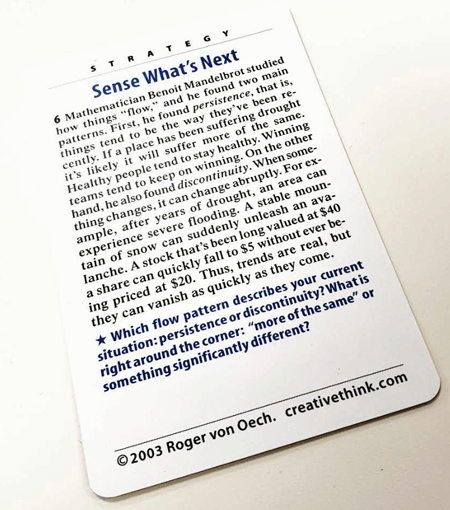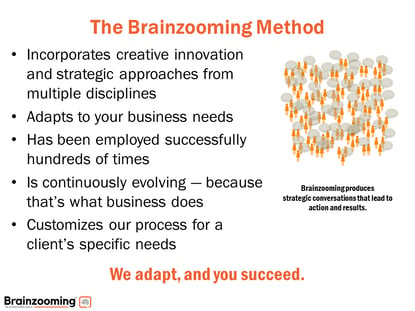Steve Lahey, the Number 1 Brainzooming Fan, posted an intriguing quote about developing organizational strategies from Amazon CEO Jeff Bezos:
“I very frequently get the question: ‘What’s going to change in the next 10 years?’ And that is a very interesting question; it’s a very common one. I almost never get the question: ‘What’s not going to change in the next 10 years?’ And I submit to you that that second question is actually the more important of the two — because you can build a business strategy around the things that are stable in time.”
Then, at a board meeting yesterday, I happened to select this creativity card from a set of innovation prompts created by creativity expert, Roger Von Oech. (affiliate link)
The two events are a reminder: You need to design your organizational strategies to account for both what will stay the same and what might suddenly and radically change.
3 Organizational Strategies for More of the Same & Significant Differences
Here are three strategic paths to pursue to account for both more of the same and disruptive change.

#1. Formalize a list of predictable things in your market
What won’t change in your business and marketplace? Who tracks these things? When developing your strategy for next year, invest time to formalize your version of this list, exploring areas where:
- Clear demographic patterns will play out over time
- There is high personal self-interest (perceptions, attitudes, and behaviors) among individuals and businesses
- Basic physiological and psychological needs are relevant (eating, sleeping, interaction, etc.)
- Patterns of stable customer behaviors exist
Use caution in differentiating between the hope that something won’t change and demonstrable evidence that it won’t change. As you develop your list, place more faith in the staying power of basic needs, while anticipating changes in how your audience fulfills those needs. After compiling your list, develop your organizational strategies to invest in the resources you’ll need to innovate these fundamentals.
#2. Freshen your brand
Ready your brand for a mix of more of the same while freshening it for what is changing. What can you include in next year’s plan to accomplish this?
- Spend time addressing your new product development and enhancement pipeline, especially with quick wins that will hit the market soon
- Update your brand’s visual identity if it’s been more than a few years since the last refresh
- Look for ways to strengthen and update the customer experience your brand delivers, whether that’s in person, on the phone, or online
- Identify the ways in which your brand can take advantage of new trends to gain greater attention and avoid looking outdated
These are just a few possibilities for boosting your brand’s relevance without losing sight of what will remain relevant.

#3. Create space to pursue potential change
Don’t overlook allocating resources toward disrupting your brand before others do. The challenge? It’s fundamentally difficult. If an organization has too much vested interest in the status quo, it can be nearly impossible to aggressively explore disruption possibilities, let alone actually act on them.
That’s why we recommend dedicating people, dollars, and space for self-disruption in your strategy plan. Look for ways to create more space, freedom, and hands-off support to facilitate exploration intent on disrupting your current business model. That’s fundamental to creating the opportunity for change.
The Old Do Both Challenge
The contrast between slow and steady and go fast and disrupt is as old as the story about the tortoise and the hare. One potential answer: understanding and leveraging what’s slow and seemingly unchanging as the platform for rapid, disruptive innovation. – Mike Brown






